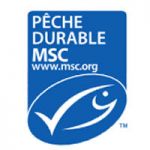 |
All about snow crab > From the market to your plate

When you buy seafood, choose wild-caught seafood with the MSC eco label, and farmed seafood under the ASC label.
When mature, male crabs are twice as big as females and measure on average 13 cm in diameter. At the market, their weight can vary from 350 g to 1.3 kg, but keep in mind that the edible part amounts to only 10% of the weight.
When purchased live, they’re wonderful. Lift the crab up, holding the shell by the sides. If it moves, it’s passed the first test. If it shows no reaction, don’t buy it. Similarly, if it has a leg missing, reject it because it may empty out when cooked.
Refuse white crabs: like other crustaceans, as the snow crab grows it goes through a succession of moltings, during which it casts off its shell and internal skeleton. A crab that has just changed shells is called a white crab and contains little meat… even less than usual!
Whole crab freezes well, preferably cooked and the meat removed from the shell. For optimal freshness, the crab should not be frozen longer than a month.
Wash the crab in fresh water to remove any particles of sand or other impurities.
You’ll also find crabmeat on the market in blocks, frozen or canned. Press the meat between your palms to extract all the canning water before continuing with a recipe. In cooking, nothing should be thrown away: save the liquid for flavoring a sauce or court-bouillon.
As for the frozen product, it doesn’t stand up to any abrupt temperature changes. Don’t even think of shortening the thawing time by putting it in the microwave or into boiling water. The crabmeat will become dry and flavorless.
Crab is cooked in court-bouillon. Immerse the live crab into boiling water. Allow about 25 minutes per kilogram.
A little foolproof trick: the top of the shell is light brown and the underside creamy white. When the crab is cooked, its shell turns orangey. That’s the time to get out your skimmer to remove it.
The meat pairs wonderfully with mayonnaise or cream. Since it is delicate, crab meat can’t compete with heavy or strongly-flavored sauces.
Crabmeat is made up of thin tender strands with a wonderfully delicate flavor; they can easily be broken up into a hot or cold sauce.
Use as a filling for crêpes with béchamel sauce flavored with a hint of curry.
In salad
Thin some mayonnaise with grapefruit juice. Combine this sauce with crabmeat, skinless grapefruit sections and avocado balls.
Crab tartlets
In a bowl, combine 325 g (12 oz.) crabmeat, 2 tbsp. mayonnaise, 2 pinches of thyme and chives, 2 tbsp. green onion, the juice of 1 lemon and 4 tbsp. olive oil. Season with salt and pepper and refrigerate. In a second bowl, combine 8 tbsp. diced cucumber, 2 tbsp. rice vinegar, 4 tbsp. olive oil, a pinch of cumin and coriander. Season with salt and pepper. Using a 7.5 cm (3”) round cookie cutter or ring mold, form a disk of the crab mixture in the center of each plate, press down, and top with cucumber salad. Gently remove the disk and serve cold as a first course.
Use the crab shell as a serving dish.
Give each guest a nutcracker and a lobster fork to remove the meat from the legs.
Don't forget finger-bowl with a slice of lemon and towels or napkins.
Photo: ID 19550390 / laperlafoto for MSCOMM

-

 Recipes
Recipes
-

 Products
Products
-

 Entertaining
Entertaining
-

 Chefs
Chefs
-

 Hints & Tips
Hints & Tips
-

 Glossaries
Glossaries








